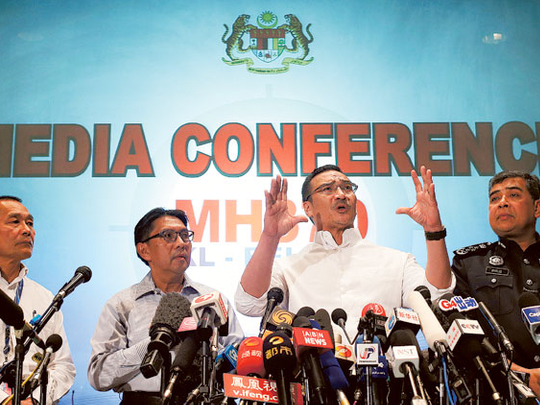
Kuala Lumpur: Malaysia’s government on Sunday asked for help from nearly a dozen Asian countries that the missing jetliner may have flown over, saying that finding the plane would be very difficult without additional data on its final movements.
Meanwhile, police were examining a flight simulator belonging to one of the pilots of the Malaysia Airlines plane, which went missing more than a week ago with 239 passengers aboard a flight from Kuala Lumpur to Beijing.
The government said police searched the homes of both of the plane’s pilots on Saturday, the first time they have done so since the plane went missing. Asked why it took them so long, police chief Inspector General Khalid Abu Bakar said authorities “didn’t see the necessity in the early stages.”
Meanwhile, US intelligence is focusing on the pilot and co-pilot’s role in the disappearance of the jet, a key US lawmaker said on Sunday.
“One thing we do know, this was not an accident. It was an intentional, deliberate act, to bring down this airplane. And the question is who is behind that,” said Michael McCaul, the chairman of the House Homeland Security Committee.
In Kuala Lumpur, Bakar told reporters that he had requested countries with citizens on board the plane to investigate their background. He said that the intelligence agencies of some countries had already done this and found nothing suspicious, but that he was waiting for others to respond.
Satellite data has shown that after losing contact with air traffic controllers, the plane could have kept flying as far north as Kazakhstan in Central Asia or deep into the southern Indian Ocean, posing awesome challenges for efforts to recover the aircraft and flight data recorders vital to solving the mystery of what happened on board. That has left authorities desperate to narrow down a search area now stretching across 11 nations and one of the most remote oceans in the world.
“The search was already a highly complex, multinational effort. It has now become even more difficult,” Acting Transport Minister Hishammuddin Hussain said at a news conference on Sunday.
“It is our hope with the new information, parties that can come forward and narrow the search to an area that is more feasible,” he said, adding that the search effort now includes 25 countries.
“The search area has been significantly expanded. And the nature of the search has changed. From focusing mainly on shallow seas, we are now looking at large tracts of land, crossing 11 countries, as well as deep and remote oceans,” Hishammuddin said.
He said the number of countries involved in the search and rescue operation had increased from 14 to 25, bringing “new challenges of co-ordination and diplomacy to the search effort.”
Australia said it was sending one of its two AP-3C Orion aircraft involved in the search to the remote islands in the Indian Ocean at Malaysia’s request. The plane will search the north and west of the Cocos Islands, a remote Australian territory with an airstrip about 1,200 kilometres southwest of Indonesia, military chief Gen David Hurley said.
Given that the northern route the plane may have taken would take it over countries with busy airspace, most experts say the person in control of the aircraft would more likely have chosen the southern route. The southern Indian Ocean is the world’s third-deepest and one of the most remote stretches of water in the world, with little radar coverage. The wreckage might take months — or longer — to find, or might never be located.
Malaysia has asked for help from countries in South, Central and Southeast Asia for assistance in tracing the jet by providing satellite and radar data, the government said in a statement. It said that for now, both the northern and southern routes that the plane may have taken were being treated with “equal importance.”
Confirmation on Saturday that someone on board severed the communication links with the ground and flew off course for more than six hours has triggered a formal criminal investigation into who on the plane was involved, and what motive they might have for doing so.
Investigators are trying answer these questions: If the pilots were involved in the disappearance, were they working together or alone, or with one or more of the passengers or crew? Did they fly the plane under duress or of their own volition? Did one or more of the passengers manage to break into the cockpit, or use the threat of violence to gain entry and then pilot the plane?
Malaysian authorities have not ruled out any possibilities, and to establish what happened with any degree of certainty investigators will likely need to examine information, including cockpit voice recordings, from the plane’s flight data recorders should the jet be located.
The government gave few details on the police investigation into the pilots. Khalid, the inspector general, said police had confiscated the flight simulator belonging to Zaharie Ahmad Shah, the 59-year-old pilot, and reassembled it in their offices to examine it. He said police also were investigating engineers and ground staff who may have had contact with the plane before it took off.
Zaharie, who has three grown children and one grandchild, previously posted photos online of the flight simulator he built for his home using three large computer monitors and other accessories. Earlier this week, the head of Malaysia Airlines said this was not in itself cause for any suspicion.
Malaysian officials and aviation experts said that whoever disabled the plane’s communication systems and then flew the jet must have had a high degree of technical knowledge and flying experience, putting one or both of the pilots high on the list of possible suspects.












